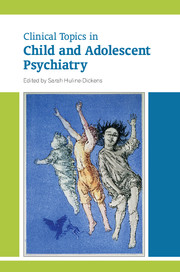Book contents
- Frontmatter
- Contents
- List of tables
- List of boxes
- List of figures
- List of contributors
- Preface
- 1 Child psychiatry and the people who have shaped it
- 2 Fabrication and induction of illness in children
- 3 Personality disorders as disorganisation of attachment and affect regulation
- 4 Post-traumatic stress disorder and attachment: possible links with borderline personality disorder
- 5 Management of antisocial behaviour in childhood
- 6 Pharmacology for attention-deficit hyperactivity disorder, Tourette syndrome and autism spectrum disorder
- 7 Pharmacology for anxiety and obsessive–compulsive disorders, affective disorders and schizophrenia
- 8 Pharmacological management of core and comorbid symptoms in autism spectrum disorder
- 9 Pharmacological treatment of depression and bipolar disorder
- 10 Cognitive–behavioural therapy with children, young people and families: from individual to systemic therapy
- 11 Anxiety disorders
- 12 Somatising: clinical presentations and aetiological factors
- 13 Somatising: management and outcomes
- 14 Evaluating psychological treatments for children with autism
- 15 Attention-deficit hyperactivity disorder: assessment and treatment
- 16 Schizophrenia
- 17 Tourette syndrome
- 18 Sleep disorders
- 19 Self-harm in adolescents
- 20 Adolescent substance misuse: an update on behaviours and treatments
- 21 Eating disorders
- 22 Gender dysphoria in young people
- 23 The psychiatry of children aged 0–4
- Index
21 - Eating disorders
Published online by Cambridge University Press: 02 January 2018
- Frontmatter
- Contents
- List of tables
- List of boxes
- List of figures
- List of contributors
- Preface
- 1 Child psychiatry and the people who have shaped it
- 2 Fabrication and induction of illness in children
- 3 Personality disorders as disorganisation of attachment and affect regulation
- 4 Post-traumatic stress disorder and attachment: possible links with borderline personality disorder
- 5 Management of antisocial behaviour in childhood
- 6 Pharmacology for attention-deficit hyperactivity disorder, Tourette syndrome and autism spectrum disorder
- 7 Pharmacology for anxiety and obsessive–compulsive disorders, affective disorders and schizophrenia
- 8 Pharmacological management of core and comorbid symptoms in autism spectrum disorder
- 9 Pharmacological treatment of depression and bipolar disorder
- 10 Cognitive–behavioural therapy with children, young people and families: from individual to systemic therapy
- 11 Anxiety disorders
- 12 Somatising: clinical presentations and aetiological factors
- 13 Somatising: management and outcomes
- 14 Evaluating psychological treatments for children with autism
- 15 Attention-deficit hyperactivity disorder: assessment and treatment
- 16 Schizophrenia
- 17 Tourette syndrome
- 18 Sleep disorders
- 19 Self-harm in adolescents
- 20 Adolescent substance misuse: an update on behaviours and treatments
- 21 Eating disorders
- 22 Gender dysphoria in young people
- 23 The psychiatry of children aged 0–4
- Index
Summary
This chapter provides an overview of classification and outcome of eating disorders, before focusing on current evidence-based treatment for the two main disorders of anorexia nervosa and bulimia nervosa. Eating disorders in childhood and adolescence present a serious threat to health and wellbeing, including medical consequences ranging from growth delay to life-threatening effects of starvation and refeeding (Nicholls et al, 2011a). Anorexia nervosa is frequently cited as the third most common chronic illness of adolescence (Lucas et al, 1991).
Setting the context: classification and epidemiology
Historically, the eating disorders (for which the majority of literature uses DSM terminology) comprise anorexia nervosa, bulimia nervosa and eating disorders not otherwise specified (EDNOS), with separate classification of feeding disorders with onset before age 6. The point at which the responsibility for food intake changes from parent to child is complex, and includes factors such as the accurate recognition of hunger and satiety, knowledge of food hygiene and handling, sensory integration of texture and smell, as well as an understanding of nutritional needs. Eating disturbance is a common manifestation of emotional issues (anxiety, mood) and a medium through which autonomy and control are negotiated. There are therefore many potential mechanisms through which the feeding to eating transition can be deviated or delayed.
The revised classification of feeding and eating disorders in DSM-5 (American Psychiatric Association, 2013) and that proposed for ICD-11 recognises this continuous process. This will be an important conceptual shift. Key changes recommended for the classification of eating disorders (Uher & Rutter, 2012) can be summarised as follows.
• The merging of feeding and eating disorders into a single grouping with categories applicable across age groups.
• Diagnosis that can be made on the basis of behaviours (e.g. parental report of excessive exercise) that indicate fear of weight gain or other underlying fears or beliefs.
• Broadening the criteria for the diagnosis of anorexia nervosa and removing the requirement for amenorrhoea; extending the weight criterion to any significant underweight; and extending the cognitive criterion to include developmentally and culturally relevant presentations.
• Reducing the frequency requirement to meet diagnostic thresholds for binge eating and vomiting.
• Including binge eating disorder as a specific category defined by subjective or objective binge eating in the absence of regular compensatory behaviour.
- Type
- Chapter
- Information
- Clinical Topics in Child and Adolescent Psychiatry , pp. 330 - 348Publisher: Royal College of PsychiatristsPrint publication year: 2014



